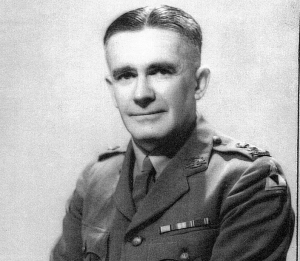Hill 200, Ulu Pandan IV (Mapanyang) 12th February 1942
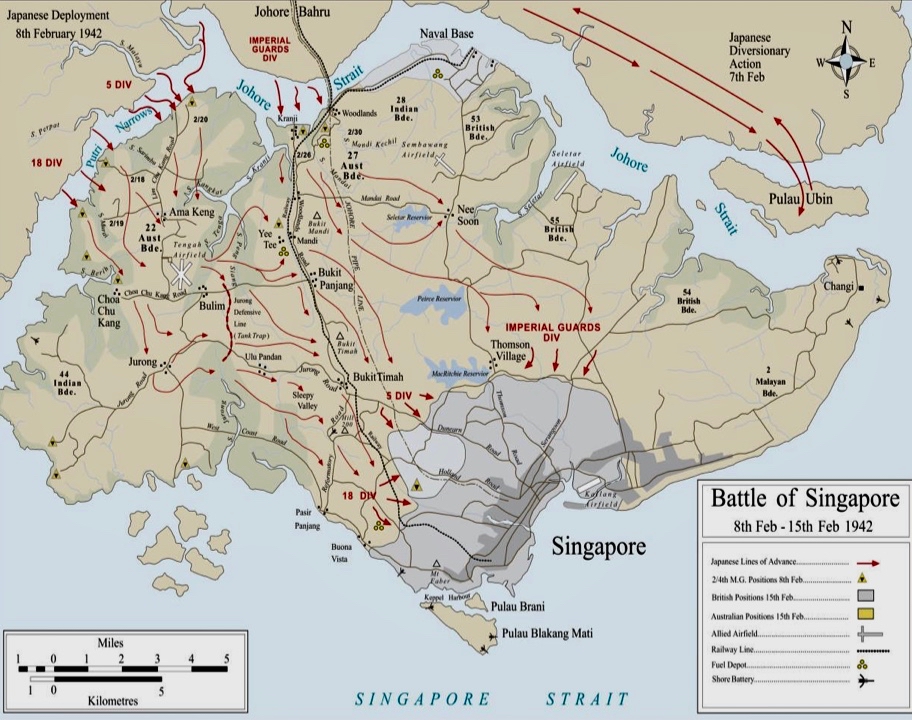
On 11/2/1942 Lt-Colonel M.J. Anketell, Commanding Officer of 2/4th MG Battalion was ordered to equip all machine gunners of his battalion he could possibly muster (many soldiers had been injured, were lost or whereabouts unknown and others had been killed in action – Japanese invasion began 8 Feb 1942.) He was to send them forward to fight as infantry on the 22nd Australian and 44th Indian Brigade’s fronts.
During the day Australians and Indians had little respite from Japanese gun and mortar fire as well as enemy air attacks.
The first solid group to arrive at 22nd Brigade’s front was a mixed company of about 90 2/4th machine gunners. Progress had been slow due to enemy air activity, but they managed to occupy Hill 200, Ulu Pandan IV at 1700 hours.
At about the same time the Signals No. 1 and AA No. 2 Platoons under the command of Capt. McEwin also took up positions approximately 300 yards south of feature Hill 200 atop a small hill. By 0930 hours on the morning of 12th February the 2/4th made up about half of the total Australian strength of 800 men.
During the nights of 11th-12th February Australian artillery did a good job keeping the enemy quiet. However the next day was a different story. The Japanese 18th Division succeeded in pushing between the Australian and Indian positions near Ulu Pandan-Holland Road junction. In an attempt to get behind 22nd Brigade’s position the Japanese began an infiltration movement around the northern flank of the machine gunners on Ulu Pandan IV.
In their attempt to outflank the Australians, the enemy had moved into a long gully between the Gordon Highlander’s position and those of the 2/4th on Ulu Pandan IV. Two detachments of machine gunners were sent to an area in the vicinity of a railway bridge on Holland Road. They moved in the gully and halted any further penetration by the enemy. All efforts by the Japanese to occupy this high feature had been thwarted and had to remain content to pour in machine gun, mortar and spasmodic artillery fire to little effect.
Just before midday 12th Feb, the enemy attempted to bring forward reinforcements from north by truck. This convoy ran into trouble in the shape of an armoured car detachment led by Cpl. Oliver Stanwell. Cpl. Stanwell’s crew destroyed the reconnaissance car and 13 trucks by the time they had finished their work. This action had successfully blocked the road for the enemy for some time.
Cpl. Oliver Stanwell later died with ‘E’ Force in Borneo.
By 1500 hours on 12th Feb the Japanese had broken through the Indians and captured Hill 150. This necessitated an adjustment to the 2/18th Battalion’s position to counter the enemy’s flanking manouvre. At about 1700 hours a patrol sighted some stationery Japanese transport vehicles – indicating the enemy had brought up fresh troops with the intention of moving in behind the left flank of 2/18th Battalion’s position. By 1800 hours heavy fire was being taken to the left rear of 2/18th Battalion however, the fire was heavier on the 2/4th MG Battalion’s position on Ulu Pandan IV.
By this time the Japanese had captured Hill 130 providing them excellent cover and the reason this feature would have been too costly in lives to regain. At dusk it was decided to reform the line by slightly withdrawing the left flank of 2/4th MG Battalion and filling the gap between 2/4th and 2/18th with another composite unit. Between 1700 and 2000 hours a great deal of action developed forward of 2/4th positions, the situation was becoming serious. The hills opposite the 2/4th on Hill 200, Ulu Pandan IV were literally infested with enemy who were too far away to harm with small arms and machine gun fire. A CDF (Call for Defensive Fire) from artillery was made but because of poor signal communications these guns could not be ranged in accurately on the enemy – an ideal opportunity to inflict heavy loss upon the Japanese was lost.
The Australians were now experiencing their first taste of the 150mm (5.9 inch) mortar nicknamed the ‘flying pig’. The pig was in fact the Model 93 (1933) smooth bore muzzle loaded mortar that had a range of 2,100 metres. The projectile for this weapon weighed 56lbs and contained 14lbs of explosives. The ‘flying pig’ is really renowned for the noise it made when its missile was airborne and for huge hole it made in the earth when it landed. It couldn’t be said this weapon ever inflicted any harm upon 2/4th men, but it certainly must have terrified many. It was about 2130 hours that Lt-Col Anketell was badly wounded.
Capt. Colin Cameron had accompanied the Colonel around his ‘C’ Company area. Because ‘C’ Company had lost hills L, K and H Lt-Col Anektell, Capt. Cameron and Major Robertson who was commanding a company from 2/20th Battalion, were on reconnaissance to define a new perimeter. Capt. Cameron reported to Major Cough, ‘D’ Company that the Colonel had been badly wounded by mortar or artillery shell burst. The R.M.O. Capt. Anderson dressed the Colonel’s wounds and sent him back to Alexandra Hospital. Meanwhile the battle to hold Ulu Pandan had only just begun. The following is taken from Col. Thyer’s report provides a good description of events as they affected the 2/4th.
‘Neither the noise tactics nor the intensity of hostile fire perturbed the machine-gunners who waited patiently until the enemy came to within 150 yards and then opened up a steady and concentrated fire on the crowded enemy. Those who got through this barrage of rifle and machine –gun bullets were dealt with by hand grenades. One Japanese attack after another was thrown back with heavy losses. Shortly afterwards Brigade orders to withdraw were issued, but it was not until 2200 hours that the Bn. Received its instructions.
By this time the enemy had gained the lower slopes of Pandan IV and Hill 130 from which was pouring small arms fire into the rear of ‘C’ Company and on a smaller knoll 300 yards to the south. The battalion closed into a tighter perimeter stubbornly resisting the enemy’s attacks. In the heavy fighting this unit suffered heavily in killed and wounded, including in the latter was Lt-Col Anketell, the CO, who later died of wounds.
By this time the MG Bn was completely surrounded and because of its inability to organize a detachment to cover the withdrawal it was obvious the battalion was not yet out of danger. To relieve pressure a counter-attack with bayonet was put in and the Japanese put to fight. In every encounter with the A.I.F. they would not face the bayonet.’
Capt. McEwin had reformed his Signals (No. 1 Platoon) and AA Platoons (No. 2) on the track near the road and led them up to a point opposite Hill 200 where he attacked with both platoons. The Japanese were holding the northeast slope of the hill and the attack pushed back to the crest. Some 2/4th were killed and there were many wounded in this attack. The wounded were sent back. Capt. McEwin pushed on again to take the crest of the hill with what is believed to have been about 20 men. On reaching the crest they attempted to consolidate their old pits, but the enemy came back strongly and only about 4 or 5 machine gunners came out.
‘With the aid of the damaged trucks placed across the road, 4 officers and 3 other ranks covered the withdrawal of 50 or more casualties to the Regimental Aid Post. By 0300 hours on the 13th Feb, the battalion now reduced to 250 all ranks was back on Cemetery Hill near Buona Vista Road triangle where it bivouacked for a well-earned respite. The West Australians had acquitted themselves magnificently. During the critical hours between 1700 hours and 2300 hours they had been supported by artillery, who despite the fact that their range was at times so short that the rounds fell among our troops, did invaluable work in relieving the pressure on Pandan IV.’
About 41 2/4th Machine Gunners were KIA or died of Wounds received at Hill 200, Ulu Pandan on 10th, 11th, 12th February 1942
WX239 ABERLE, John Roughton – ‘C’ Coy 10 Platoon, KIA 12 Feb, Ulu Pandan
WX9828 ADAMS, Arthur Alfred – ‘C’ Coy 11 Platoon KIA 11 Feb, Ulu Pandan
WX3376 ANKETELL, Michael Joseph, Commanding Officer 2/4th M G Battalion.
Wounded 12 Feb Ulu Pandan – Anketell as was his habit (and not a safe one) had scoured ahead to try to sight the Japanese. These were tense times, the troops fighting for survival. Tragically Anketell was hit by one of his own men. Dr. Anderson sought to dress his wounds, and Anketell was transported away.
The facts of this were kept very quiet, with only a handful of 2/4th men aware of the facts. We know the unnamed soldier involved lost his life in North Borneo at Sandakan – he had thought Anketell was enemy as they had been surrounded.
Anketell was evacuated to Alexandra Hospital where he died at 7.45pm on 13 Feb 1942 aged 51 years.
WX8650 BISHOP, Hector John – HQ No. 3 Platoon, KIA 12 Feb, Ulu Pandan
WX7947 BROWN, Allan Roy – HQ 3 Platoon, KIA 12 Feb, Reformatory Road, Ulu Pandan
WX7469 BUTLER, Thomas Joseph HQ No. 3 Platoon WIA 12 Feb. Recd Chest wound (and possible throat wound) during bayonet charge at Hill 200, Ulu Pandan. Evacuated to 2/13 AGH where he died in hospital of pneumonia 14 Feb 1942 aged 34 years.
WX17860 CAIN, Henry David
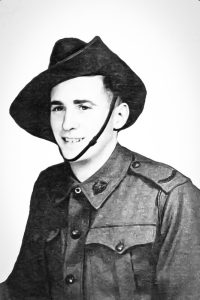
‘A’ Coy HQ, KIA 12 Feb, Hill 200, Ulu Pandan (Reinforcement)
Cain was son of Richard and Vera Cain of Donnybrook. He enlisted with AIF on 13 December 1941! Barely trained when he was included in reinforcements taken to Fremantle to board ‘Aquitania’ on 15 Feb 1942 when he joined ‘A’ Coy HQ under CO Major Saggers (soon after transferred to ‘E’ Coy & SRB) & 2 I/ c Capt Thomas & Lt McCaffrey.
WX7479 CANNON, Reginald Francis – HQ No. 1 Signals, KIA 12 Feb Hill 200, Ulu Pandan
WX8192 CARLISLE, Robert James – ‘C’ Coy 10 Platoon KIA 11 Feb Reformatory Road, Ulu Pandan
WX11584 CASE, William Cecil – ‘C’ Coy HQ, KIA 12 Feb, Hill 200, Ulu Pandan
WX7163 CLARE, John – ‘C’ Coy 10 Platoon, KIA 11 Feb, Ulu Pandan
WX3446 CURNOW, Francis Lyle C.O. HQ 1 Signals KIA 12 Feb, Hill 200, Ulu Pandan. Sgt, Ben Hansen was KIA and with Royce, Phillips and Innes dead, CPL Rutherfod took over command of the Signals Platoon. Rutherford died illness with V Battalion Oct 1943 aged 22 years at Chungkai Hospital. Rutherford promoted posthumously to Lieutenant.
WX9561 DAHLBERG, Albert Edward – Corporal of 88 LAD KIA 10 Feb Reformatory Road, Ulu Pandan aged 30 years.
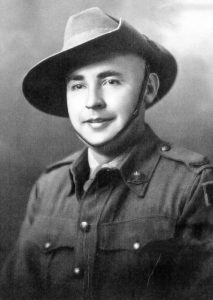
Albert’s mother widowed Bertha Dahlberg was known to have premonitions and during her lifetime foretold many events.
‘She told her family during the early hours of the morning of the day Albert died, 10th February 1942, he came to say goodbye to her. He called out to Bertha, “Mum” from the doorway of her bedroom. Albert was dressed in white and she replied “Oh my son, you are home, thank God you are home. I have prayed for this.” As Bertha moved towards Albert his image receded and faded into the room behind.
In the family kitchen the following morning, a distressed Bertha told her family her story and of seeing Albert. She knew he was dead. The family believed her to be overwrought and said she had had a dream which appeared so vivid because she was worried.‘
Bertha and the Dahlberg family did not receive confirmation and news of Albert’s death until early 1946.
Albert had given his sweetheart Mary an engagement ring – known only to the immediate family. They planned to announce their wedding plans when Albert returned.
WX10114 EASTWOOD, Harold – HQ 1 Pl Signals, KIA 10 Feb Reformatory Road, Ulu Pandan
WX7620 EDWARDS, Thomas Henry ‘D’ 16 Ptn KIA 0500 hours 12 Feb Hill 200, Ulu Pandan– Wounded in trench by shell burst from enemy artillery fire at Hill 200, Ulu Pandan. Stretcher bearers carried him to RAP 100 yards away. Capt Anderson 2/4th, pronounced Edwards dead.
WX9039 FITZPATRICK, Richard Newell Sgt, HQ Transport No. 3 Platoon, KIA 12 Feb, Hill 200, Ulu Panda.
WX906 GOSSAGE, George John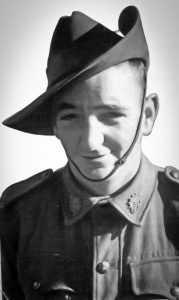 HQ No. 1 Signals, KIA 12 Feb, Hill 200, Ulu Pandan aged 26 years (believed to have received gunshot wound to stomach during bayonet charge Hill 200).
HQ No. 1 Signals, KIA 12 Feb, Hill 200, Ulu Pandan aged 26 years (believed to have received gunshot wound to stomach during bayonet charge Hill 200).
Born Kalgoorlie to parents George Victor and Annie Elizabeth Gossage, his father was a Crane Driver with WAGR. The family moved to Bridgetown where George spent his formative years. He was living with his widowed mother in East Perth before enlisting AIF 25 Oct 1940.
WX15872 GRAY, Lindsay Campbell – HQ No. 2 Anti Aircraft, KIA 12 Feb, Reformatory Road, Ulu Pandan
WX10678 HANSEN, Benjamin Edwin Sgt, – HQ No.1 Platoon, KIA 12 Feb, Reformatory Road, Ulu Pandan
WX11202 HAYES, Keith Thomas – ‘C’ Coy, 10 Platoon, KIA 12 Feb, Hill 200, Ulu Pandan
WX9755 HELLIWELL, Leonard – ‘C’ Coy HQ, KIA 12 Feb Hill 200, Ulu Pandan aged 43 years.
WX5181 HOWELL, Kenneth Jack – ‘C’ Coy, 10 Platoon KIA 11 Feb, West Ulu Pandan
WX9552 INNES, William Leonard Sgt, HQ 2 AA, KIA 12 Feb Hill 200, Ulu Pandan (replaced L/Sgt Phillips)
WX8484 MANNING, Herbert John Lt. C.O ‘A’ Coy 4 Ptn, DOW 12 Feb Hill 200, Ulu Pandan (took command No. 4 Platoon originally shared with Lt. McCaffery)
WX3442 McEWIN, Oswald Sydney Capt, CO Company HQ, KIA 12 Feb, Hill 200, Ulu Pandan
WX98787 MUSSMAN, Alfred Charles – ‘C’ Coy, 11 Platoon, KIA 11 Feb, Reformatory Road, Ulu Pandan aged 30 years having received wounds to his head.
Born Adelaide, SA in 1911, teenage Mussman showed promise as a football player before moving to League Competition. He moved to WA to play with East Perth from Sturt Football Club.
WX12628 OLIVER, Stirling John, Acting
Corp – ‘C’ Coy HQ WIA 11 Feb, Ulu Pandan, DOW 13 Feb
WX9129 OVENS, Enest Jesse – HQ 1 Ptn Signals, KIA 12 Ulu Pandan (Signaller)
WX7458 PEAT, Leonard Oswald Coy HQ, KIA 12 Feb Ulu Pandan, Reformatory Road.
WX10389 PHILLIPS, Cecil Allen L/Sgt – HQ 2 Pln, AA KIA 12 Feb Ulu Pandan, Reformatory Road
WX15829 RADBURN, Harold ‘A’ Coy HQ, KIA 12 Feb Hill 200, Ulu Pandan (Reinforcement)
WX10793 ROWELL, Edward John Cpl, ‘C’ Coy 11 Ptn KIA 12 Feb Hill 200, Ulu Pandan
WX9383 ROYCE, John Douglas Lt. CO of HQ 2 Platoon DOW 12 Feb, Hill 200, Ulu Pandan. Both his Sgts Phillips and Innes were KIA.
WX8646 SPOUSE, Arthur Percival L/Corp – ‘C’ Coy 12 Pln KIA 12 Feb, Possibly Hill 200, Ulu Pandan
WX9330 SQUIRE, Dudley Joseph ‘C’ Coy, 11 Platoon. KIA 12 Feb, Hill 200, Ulu Pandan
WX7563 SULLIVAN, Edmund Herbert HQ 3 Platoon, KIA 12 Feb, Hill 200 Ulu Pandan
WX7470 TODD, Richard Lloyd HQ 2 AA, KIA 12 Feb, Reformatory Road, Ulu Pandan
WX9224 WALKER, Harold Alexander HQ Signaller, KIA 12 Feb, Reformatory Road, Ulu Pandan
WX8626 WARNE, Neil – HQ 1 Platoon Signals, KIA 12 Feb, Hill 200 Ulu Pandan (Signaller)
WX7166 WERRETT, Herbert Stanley ‘C’ Coy, 11 Platoon, DOW 14 Feb Alexander Hospital, WIA possibly Ulu Pandan
1 X Battalion Headquarters
2 X Company Headquarters
7 X HQ No. 1 Platoon Signals
5 X HQ No. 2 Anti-Aircraft
5 X HQ No. 3 Platoon
16 X ‘C’ Coy
1X ‘D’ Coy
3 X ‘A’ Coy
1 X 88th LAD
Those wounded included:
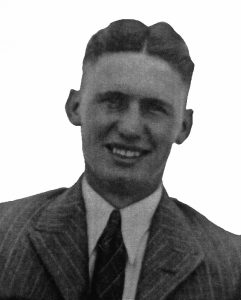
WX1587 TOOVEY, Francis Andrew ‘D’ Coy 15 Platoon. Wounded Hill 200, Ulu Pandan. Toovey remained hospitalised Singapore and returned to WA via hospital ship ‘Oranje’ to Sydney and by train to Perth. Sadly he died 9 Nov 1945 in hospital Perth aged 27 years.
He was son of Henry Weir Toovey and Harriett Rosa Doust of Cranbrook.
___________________
WX3444 Alfred John COUGH MAJOR,
Commanding Officer ‘D’ Company.
Alf Cough composed the following poem whilst interned at Sime Road POW Camp, Singapore. He included it in his diary dated 20 December 1942 – just a few days after he had finally been granted official permission to take a search party out to find bodies of men killed at Hill 200.
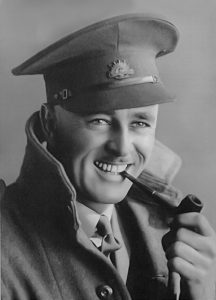
HILL 200
Hill 200 – just one of so many
That were scenes of action and death
Raked and torn by screaming destruction
Which came with the War’s scorching breath
Deep wounds in the green of the hillside
Gaped wide where the red soil upturned
Ran like blood, thru the bracken that withered
Neath that breath which blistered and burned.
Hill 200 – now peaceful and quiet
Few signs of the battle remain.
The red wounds are covered by nature
With green; and the wind sighs again
Thru the bracken, its roots ever searching
For life in the red soil below,
Mingling there in the bones of our comrades
Who Sleep. Never old will they grow.
A plain wooden cross on that hilltop –
Overlooking a peaceful terrain
The scene of the last gallant action
They fought and died for in vain –
Marks the last resting place of comrades
Who fell neath the beneath the foeman’s glaive
Death is their portion, with Glory
And honour – the reward of the brave.
Written Syme Road, Singapore
20th December 1942
In mid December 1942, 10 months after capitulation, Cough and Saggers who were both interned at Sime Road with large numbers of 2/4th men, were finally granted permission by the Japanese to locate and identify their men who had died in battle. (Saggers to Bukit Timah area however the rapid jungle growth hampered his party’s effort to identify the locations).
Cough’s party were distressed to discovered the Japanese had long ago buried their dead, their graves lying amongst the Australian bodies. The Japanese could have so easily moved them to a nearby slit trench instead they had worked amongst the Australian dead to dig their graves! The tropical climate and wild animals had destroyed nearly all evidence. It was distressing for the men.
The party erected a wooden cross on top of Hill 200 and took back with them a few items of identity.
It was an unforgivable action by the Japanese.

